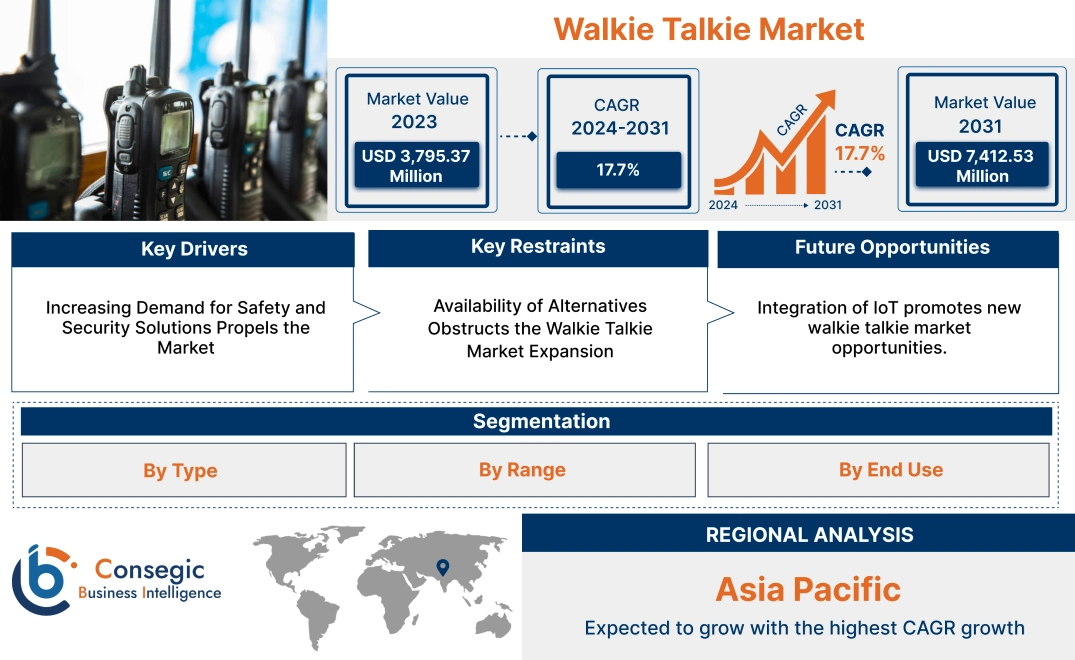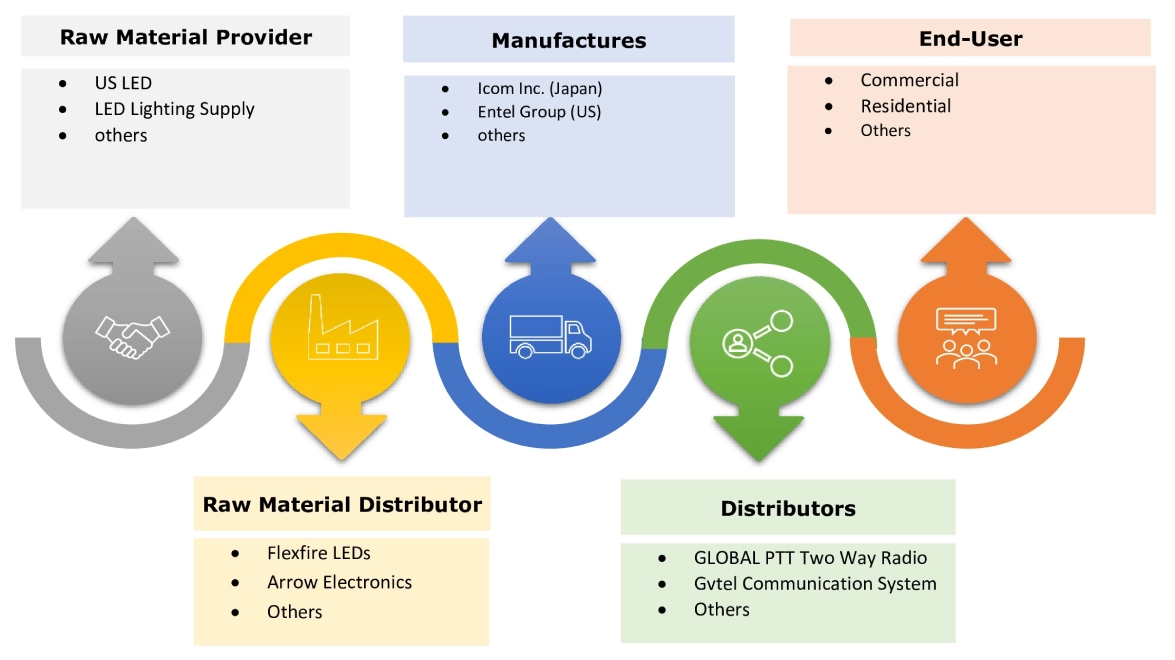- Summary
- Table Of Content
- Methodology
Walkie Talkie Market Size:
Walkie Talkie Market size is estimated to reach over USD 7,412.53 Million by 2031 from a value of USD 3,795.37 Million in 2023 and is projected to grow by USD 4,059.00 Million in 2024, growing at a CAGR of 17.7% from 2024 to 2031.
Walkie Talkie Market Scope & Overview:
A walkie talkie (WT) is a battery-powered device used for communication that receives and transmits data. It looks similar to a telephone handset, with an antenna mounted on the top of it. It provides a reliable communication channel during emergencies, especially in sectors such as public safety, construction, and event management, where real-time coordination is critical. It is used for different purposes including commercial interest, personal activity, training activity, military activity, tourist industry activity, and others. The ability to operate independently of cellular infrastructure makes it an essential tool for ensuring safety and responding swiftly to critical situations. As security concerns continue to rise globally, the demand for a reliable communication tool is expected to grow, in turn driving the market.
Walkie Talkie Market Dynamics - (DRO) :

Key Drivers:
Increasing Demand for Safety and Security Solutions Propels the Market
Walkie talkies provide a reliable, real-time communication tool in critical situations where fast coordination is essential, particularly in industries including public safety, construction, and event management. Their key benefit is their ability to function independently of cellular networks, ensuring uninterrupted communication during emergencies, power outages, or in remote areas. This makes them ideal for security purposes. Additionally, they are widely used for crowd control for larger events and in ensuring worker’s safety on construction sites.
- In November 2023, JVC Kenwood, a Japan-based company, launched the TH-D75 dual band walkie talkie, featuring advanced capabilities for secure and safe operations.
Thus, the analysis shows that the growing advancements related to walkie talkie for safety and security applications are driving the walkie talkie market growth.
Key Restraints :
Availability of Alternatives Obstructs the Walkie Talkie Market Expansion
Walkie-talkie has various substitutes such as mobile phones, satellite phones, and others. Comparatively, the substitutes have similar performance and applications, with respect to WT, which is a significant factor restricting the market growth.
Additionally, the aforementioned substitutes offer several advantages such as broader coverage, advanced features, and more reliable communication in diverse conditions. Further, they provide greater convenience and integration with other communication platforms. Therefore, the availability of various substitutes is limiting the walkie talkie market growth.
Future Opportunities :
Integration of IoT promotes new walkie talkie market opportunities.
IoT-enabled devices can connect with other smart devices, allowing real-time data sharing, GPS tracking, and remote monitoring, which enhances both safety and operational efficiency. In industries such as logistics and manufacturing, IoT integration enables seamless tracking of equipment and personnel, optimizing workflow and improving response times during emergencies. Additionally, IoT allows for predictive maintenance of devices, reducing downtime and cost associated with repairs. As industries are increasingly adopting IoT-driven solutions, integrating IoT can significantly improve the market.
- In May 2024, Karri raised 983k dollars in pre-seed funding to launch a GPS-enabled, data-based walkie-talkie for kids.
Thus, the analysis states that integration of IoT is in trend and presents significant growth for the walkie talkie market opportunities.
Walkie Talkie Market Segmental Analysis :
By Type:
Based on the type, the market is segmented into analog and digital.
Trends in the type:
- Analog devices are preferred in budget-conscious industries requiring basic, reliable communication for short-range tasks.
- Digital devices are in trend due to advanced features such as GPS, encryption, and others for secure, efficient communication.
The analog segment accounted for the largest revenue share of the total walkie talkie market share in 2023.
- Analog modulation technique is used by analog WT, which is ideal for simple and direct communication.
- They are less expensive and have longer battery life compared to digital devices.
- It is reliable for short-range communication such as schools, retail, and small business for simple communication.
- In May 2021, Yanton launched T-X7D an analog WT that offers seamless POC and analog dual-mode switching, clear audio, and user-friendly dual PTT buttons.
- In conclusion, the growing advancements in analog WT for cost-efficient solutions with better audio quality are driving the walkie talkie market demand.
The digital segment is anticipated to register the fastest CAGR during the forecast period.
- Digital WT uses a digital modulation technique that converts voice into digital signals, offering clearer and interference-resistant communication.
- They provide enhanced audio quality, extended range, and additional features like encryption and GPS.
- It can be used in complex environments such as emergency services, logistics, and large-scale events where secure, high-quality communication is required.
- In April 2022, Motorola launched the MOTOTRBO R7, a rugged digital two-way radio with advanced audio and safety features, across EMEA.
- Thus, according to the walkie talkie market analysis, the rising innovations in digital two-way radios are driving the digital segment.
By Range:
Based on the range, the walkie talkie industry is segmented into short-range, medium-range, and long-range.
Trends in the Range:
- Adoption of medium-range devices is redefining outdoor communication with advanced features tailored for harsh environments.
- Short-range devices are lightweight, portable, and easy to use, which is increasing their adoption for quick communication in small areas.
The short-range segment accounted for the largest revenue at 43.94% of the overall walkie talkie market share in 2023.
- Short-range WTs are small and compact portable devices used for close proximity communication.
- They are small and lightweight, which makes them mobile and low-cost options for wireless communication over short distances.
- It is commonly used in indoor environments such as small businesses, schools, and hospitals.
- In September 2020, Talk PRO launched X-10, a lightweight, license-free, short-range two-way radio with a 2-3km range that is ideal for retail communication.
- Therefore, the rising adoption of short-range WT in schools, small businesses, and hospitals is driving the walkie talkie market demand.
The long-range segment is anticipated to register the fastest CAGR during the forecast period.
- Long range walkie talkies support communication over greater distances, often more than 5 miles depending on the environmental conditions.
- Long-range models offer extended reach, making them ideal for communication across larger areas or challenging conditions.
- They are essential for outdoor activities, construction sites, security operations, and areas where communication over vast distances is crucial.
- In November 2023, Hyetra launched P30 in their PoC public network series with improved low latency, strong signal transmission, improved voice quality, and others for long-range communication.
- According to the analysis, technological advancement in the long-range segment is boosting the walkie talkie market trends.
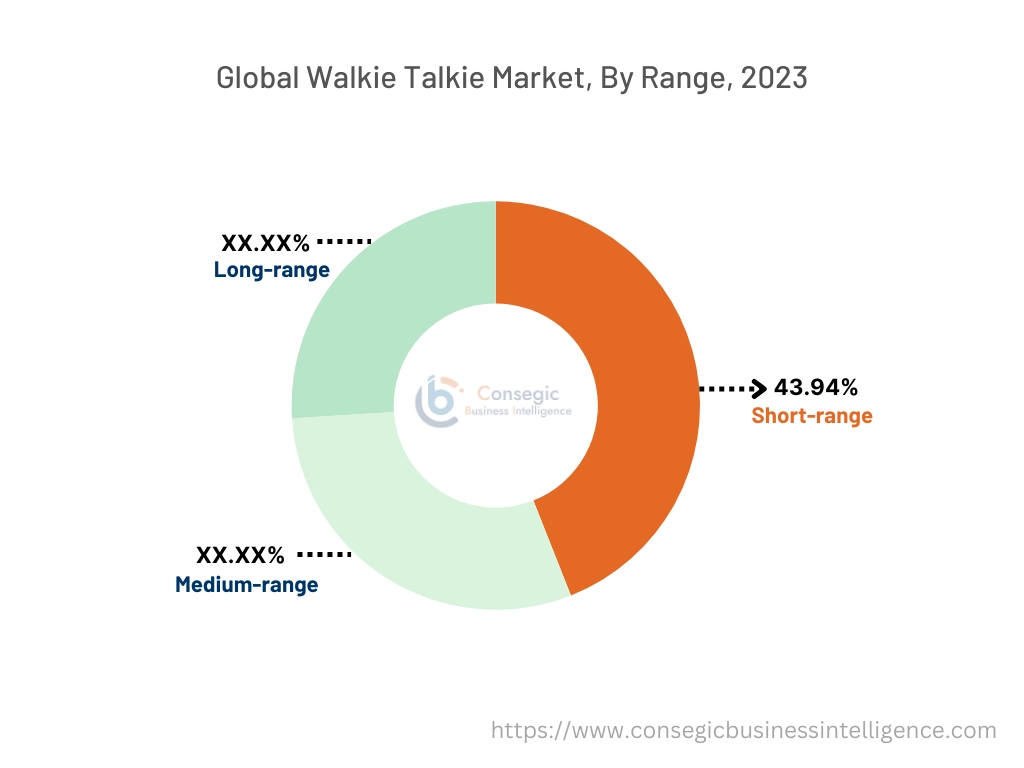
By End Use
Based on end use, the market is segmented into commercial, residential, military & defense, and others.
Trends in the End Use:
- In the military and defense industry, it is used by armed forces for secured and encrypted communication.
- They are utilized across various industries and applications, such as marine and aviation, tailored to meet specific communication requirements.
The commercial segment accounted for the largest revenue share in 2023 and is anticipated to register the fastest CAGR during the forecast period.
- Communication equipment is necessary in industries such as logistics, construction, hospitality, and manufacturing.
- It has long-range capabilities for long distances and can be integrated with other workplace communication systems.
- It allows seamless coordination and efficient communication among teams and workers.
- For instance, Hytera launched the commercial G36 walkie-talkie in 2023, featuring a lightweight design and advanced noise reduction for clear communication in various industries.
- The analysis highlights a growing trend in advancements that enable commercial industries to operate more efficiently and boost productivity, driving market growth.
Regional Analysis:
The regions covered are North America, Europe, Asia Pacific, the Middle East and Africa, and Latin America.
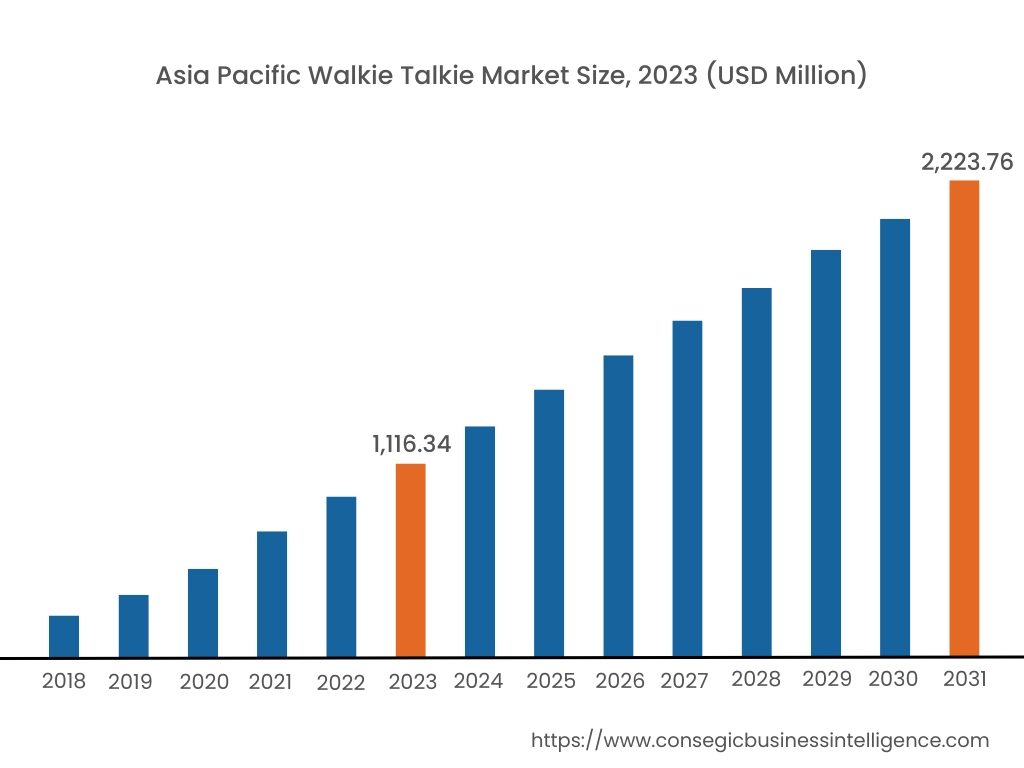
Asia Pacific region was valued at USD 1,116.34 Million in 2023. Moreover, it is projected to grow by USD 1,195.87 Million in 2024 and reach over USD 2,223.76 Million by 2031. Out of this, China accounted for the maximum revenue share of 27.0%. As per the walkie talkie market analysis, increasing investments in commercial, construction, and digital infrastructure, particularly in countries like China and India, are driving growth. Rapid digitalization and the rising demand for speech clarity and better coverage in industries such as aerospace, security, and defense further accelerate regional growth.
- For instance, Kirisun, a Chinese company, launched the UP405S, a commercial digital walkie-talkie that adopts the DMR standard and boasts high-cost performance, stability, and performance.
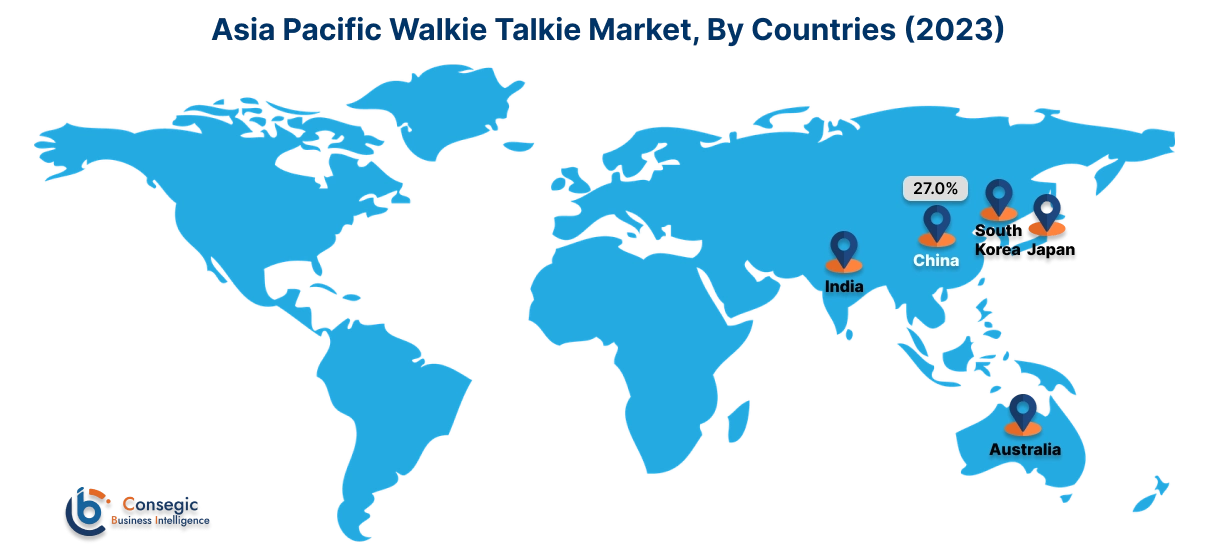
North America is estimated to reach over USD 2,223.76 Million by 2031 from a value of USD 1,148.00 Million in 2023 and is projected to grow by USD 1,226.91 Million in 2024. The expansion of walkie talkie industry is driven by the increasing government investments in security-related technologies for public safety and emergency response, which is driving the demand among first responders and law enforcement. Additionally, sectors like hospitality rely on it for efficient communication, further driving the walkie talkie market expansion.
- In September 2024, Midland Radio Corporation partnered with Bronco owners to equip both participants and tour staff with GMRS two-way radios to ensure safety and security during the premier off-road tour.
The regional trends analysis depicts that the increasing focus on manufacturing, construction, logistics, and transportation in Europe is driving the adoption of advanced communication tools, including WT. The rising number of residential projects in the Middle East and Africa is boosting the adoption of walkie-talkies in this region. Key sectors such as commercial, residential, and military and defense for walkie-talkies are driving the walkie talkie market trends in Latin America.
Top Key Players & Market Share Insights:
The walkie talkie market is highly competitive with major players providing services to the national and international markets. Key players are adopting several strategies in research and development (R&D), product innovation, and end-user launches to hold a strong position in the market. Key players in the global walkie talkie market include -
- Icom Inc. (Japan)
- Entel Group (US)
- Shenzhen Hqt Science & Technology Co., Ltd. (China)
- Motorola Soultions, Inc. (US)
- Hytera Communications Corporation Limited (China)
- Uniden Holdings Corporation (Japan)
- Hongkong Retevis Trade Co., Ltd (China)
- Jvc Kenwood (Japan)
- Kirisun Communication Co., Ltd (China)
- Tait Communications (New Zealand)
Recent Industry Developments :
Product Innovations:
- For instance, in July 2024, Innovative Eyewear Inc. launched a walkie-talkie feature on Lucyd Eyewear, this enables unlimited voice conferencing and provides instant communication.
Product Launches:
- For instance, in August 2022, Sonim Technologies released the XP5plus a two-way communication walkie-talkie in Canada, which is used by industrial workers.
Walkie Talkie Market Report Insights :
| Report Attributes | Report Details |
| Study Timeline | 2018-2031 |
| Market Size in 2031 | USD 7,412.53 Million |
| CAGR (2024-2031) | 8.7% |
| By Type |
|
| By Range |
|
| By End Use |
|
| By Region |
|
| Key Players |
|
| North America | U.S. Canada Mexico |
| Europe | U.K. Germany France Spain Italy Russia Benelux Rest of Europe |
| APAC | China South Korea Japan India Australia ASEAN Rest of Asia-Pacific |
| Middle East and Africa | GCC Turkey South Africa Rest of MEA |
| LATAM | Brazil Argentina Chile Rest of LATAM |
| Report Coverage |
|
Key Questions Answered in the Report
How big is the Walkie Talkie Market? +
Walkie Talkie Market size is estimated to reach over USD 7,412.53 Million by 2031 from a value of USD 3,795.37 Million in 2023 and is projected to grow by USD 4,059.00 Million in 2024, growing at a CAGR of 17.7% from 2024 to 2031.
What specific segmentation details are covered in the walkie talkie market report? +
The walkie talkie market report includes specific segmentation details for type, range, end-use, and region.
Which is the fastest segment anticipated to impact the growth? +
In the end use, the commercial segment is the fastest-growing segment during the forecast period.
Who are the major players in the walkie talkie market? +
The key participants in the walkie talkie market are Icom Inc. (Japan), Entel Group (US), Uniden Holdings Corporation (Japan), Hongkong Retevis Trade Co., Ltd (China), Jvckenwood USA Corporation (US), Kirisun Communication Co., Ltd (China), Tait Communications (New Zealand), Shenzhen Hqt Science & Technology Co., Ltd. (China), Motorola Soultions, Inc. (US), Hytera Communications Corporation Limited (China).
